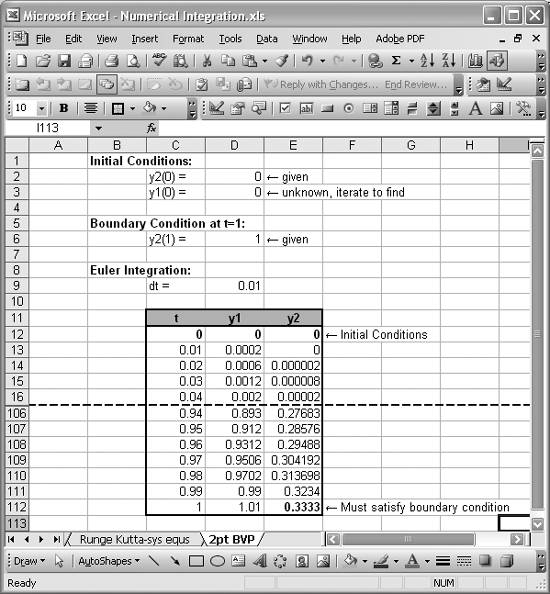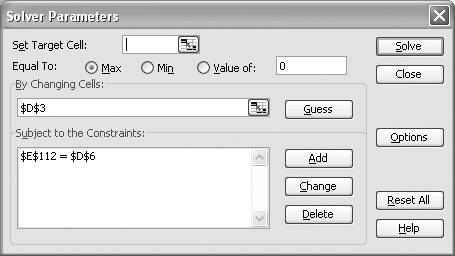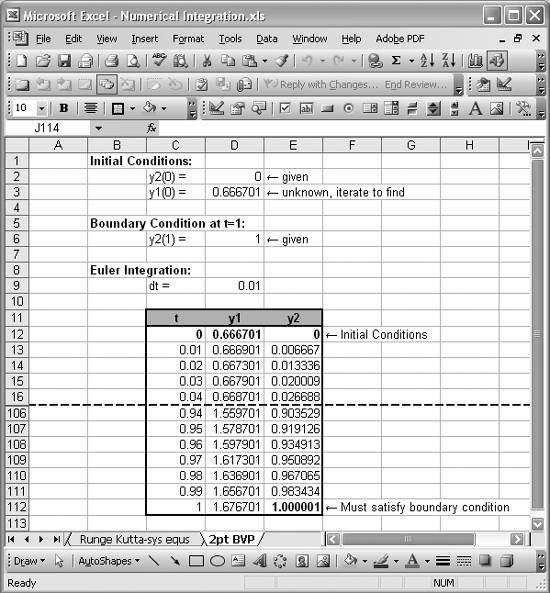Shooting Boundary Value Problems
Problem
You need to numerically solve a boundary value problem where you're given an ordinary differential equation and boundary conditions in the problem domain.
Solution
You can use the shooting method to solve the boundary value problem in Excel.
Discussion
The shooting method is a well-known iterative method for solving boundary value problems . Consider this example:

This is a second-order equation subject to two boundary conditions, or a standard two-point boundary value problem .
Let y2 = u and y1 = du/dt = dy2/dt to reduce this second-order equation to two first-order equations:

The shooting method attempts to solve this sort of problem as an initial value problem using a marching algorithm like Euler's method or the Runge-Kutta method, as discussed earlier in this chapter. The problem is that the initial conditions are not fully specified; du/dt at t = 0 is unknown. This is the same as saying y1(0) in the reduced system is unknown. Therefore, the shooting method requires you to make an initial guess at the unknown initial condition and then implement a marching algorithm over the problem domain. Once that is complete, you have to check to see if the values obtained at the end of the marching process satisfy the given boundary conditions at the end of the boundary. If they are not satisfied, you have to assume new values for the unknown initial conditions, redo the marching solution, and then check the end boundary conditions again. You repeat this process until you converge on a solution that satisfies all boundary conditions. This iterative process is ideally suited to Excel's Solver tool.
You can readily set this problem up in Excel and solve it using a combination of Solver and a method such as Euler's method. Figure 11-7 shows the spreadsheet I set up to solve the reduced system of equations shown earlier.
At the top of this spreadsheet you can see where I entered the given boundary conditions into several cells. I divided these into initial conditions that will serve as initial conditions for the marching algorithm, and a boundary condition at the end of the problem domain (t = 1). Make sure you notice that the initial condition y1(0) is unknown. The value shown in cell D3 is an assumed initial value. We're going to use Solver to find it later.
The meat of this spreadsheet is the table you see in the middle of Figure 11-7, which implements Euler's method to solve the reduced system of equations. The values at t = 0 in this table contain the initial conditions. For example, the cell containing y1 at t = 0 (cell D12) contains the cell formula =D3, referring back to the unknown initial condition. Similarly, the cell containing y2 at t = 0 (cell E12) contains the cell formula =D2 referring back to the given initial condition.
Figure 11-7. Two-point boundary value problem setup

All of the other cells in this table contain formulas like =D12+2*C13*$D$9 for the y1 column and =E12+D12*$D$9 for the y2 column. These formulas correspond to the Euler integration formulas for this problem shown here:

|
Notice in Figure 11-7 that the computed value for y2 at the end of the domain, t = 1, does not satisfy the given boundary condition. This is because my assumed initial condition, y1(0) = 0, is not the correct initial condition. However, we can use Solver to find it iteratively, subject to the constraint that the value in cell E112 must be equal to the value in cell D6 in order to satisfy the boundary conditions. Figure 11-8 shows the Solver model I set up for this problem.
Figure 11-8. Solver model for two-point boundary value problem

Just as in Recipe 9.4, I didn't specify a target cell. Instead, I specified only a cell to change subject to a single constraint. Solver will automatically set up a dummy target cell if one is not specified. The value of that target cell is irrelevant to the solution. The cell to change for this problem is the value of the unknown initial condition. The constraint consists of requiring the computed value of y2 at the end of the problem domain to equal the given boundary condition. (See Recipe 9.4 to learn how to add constraints in Solver).
Setting up this Solver model and pressing the Solve button starts the iterative solution process, resulting in the solution shown in Figure 11-9.
Figure 11-9. Two-point boundary value problem solution

As you can see, Solver found a solution satisfying the specified constraint. It turns out that the correct initial condition for y1 is 0.666701. At this point the problem is solved and you can plot the results if you desire. (See Chapter 4 to learn how to create charts in Excel.)
Using Excel
- Introduction
- Navigating the Interface
- Entering Data
- Setting Cell Data Types
- Selecting More Than a Single Cell
- Entering Formulas
- Exploring the R1C1 Cell Reference Style
- Referring to More Than a Single Cell
- Understanding Operator Precedence
- Using Exponents in Formulas
- Exploring Functions
- Formatting Your Spreadsheets
- Defining Custom Format Styles
- Leveraging Copy, Cut, Paste, and Paste Special
- Using Cell Names (Like Programming Variables)
- Validating Data
- Taking Advantage of Macros
- Adding Comments and Equation Notes
- Getting Help
Getting Acquainted with Visual Basic for Applications
- Introduction
- Navigating the VBA Editor
- Writing Functions and Subroutines
- Working with Data Types
- Defining Variables
- Defining Constants
- Using Arrays
- Commenting Code
- Spanning Long Statements over Multiple Lines
- Using Conditional Statements
- Using Loops
- Debugging VBA Code
- Exploring VBAs Built-in Functions
- Exploring Excel Objects
- Creating Your Own Objects in VBA
- VBA Help
Collecting and Cleaning Up Data
- Introduction
- Importing Data from Text Files
- Importing Data from Delimited Text Files
- Importing Data Using Drag-and-Drop
- Importing Data from Access Databases
- Importing Data from Web Pages
- Parsing Data
- Removing Weird Characters from Imported Text
- Converting Units
- Sorting Data
- Filtering Data
- Looking Up Values in Tables
- Retrieving Data from XML Files
Charting
- Introduction
- Creating Simple Charts
- Exploring Chart Styles
- Formatting Charts
- Customizing Chart Axes
- Setting Log or Semilog Scales
- Using Multiple Axes
- Changing the Type of an Existing Chart
- Combining Chart Types
- Building 3D Surface Plots
- Preparing Contour Plots
- Annotating Charts
- Saving Custom Chart Types
- Copying Charts to Word
- Recipe 4-14. Displaying Error Bars
Statistical Analysis
- Introduction
- Computing Summary Statistics
- Plotting Frequency Distributions
- Calculating Confidence Intervals
- Correlating Data
- Ranking and Percentiles
- Performing Statistical Tests
- Conducting ANOVA
- Generating Random Numbers
- Sampling Data
Time Series Analysis
- Introduction
- Plotting Time Series Data
- Adding Trendlines
- Computing Moving Averages
- Smoothing Data Using Weighted Averages
- Centering Data
- Detrending a Time Series
- Estimating Seasonal Indices
- Deseasonalization of a Time Series
- Forecasting
- Applying Discrete Fourier Transforms
Mathematical Functions
- Introduction
- Using Summation Functions
- Delving into Division
- Mastering Multiplication
- Exploring Exponential and Logarithmic Functions
- Using Trigonometry Functions
- Seeing Signs
- Getting to the Root of Things
- Rounding and Truncating Numbers
- Converting Between Number Systems
- Manipulating Matrices
- Building Support for Vectors
- Using Spreadsheet Functions in VBA Code
- Dealing with Complex Numbers
Curve Fitting and Regression
- Introduction
- Performing Linear Curve Fitting Using Excel Charts
- Constructing Your Own Linear Fit Using Spreadsheet Functions
- Using a Single Spreadsheet Function for Linear Curve Fitting
- Performing Multiple Linear Regression
- Generating Nonlinear Curve Fits Using Excel Charts
- Fitting Nonlinear Curves Using Solver
- Assessing Goodness of Fit
- Computing Confidence Intervals
Solving Equations
- Introduction
- Finding Roots Graphically
- Solving Nonlinear Equations Iteratively
- Automating Tedious Problems with VBA
- Solving Linear Systems
- Tackling Nonlinear Systems of Equations
- Using Classical Methods for Solving Equations
Numerical Integration and Differentiation
- Introduction
- Integrating a Definite Integral
- Implementing the Trapezoidal Rule in VBA
- Computing the Center of an Area Using Numerical Integration
- Calculating the Second Moment of an Area
- Dealing with Double Integrals
- Numerical Differentiation
Solving Ordinary Differential Equations
- Introduction
- Solving First-Order Initial Value Problems
- Applying the Runge-Kutta Method to Second-Order Initial Value Problems
- Tackling Coupled Equations
- Shooting Boundary Value Problems
Solving Partial Differential Equations
- Introduction
- Leveraging Excel to Directly Solve Finite Difference Equations
- Recruiting Solver to Iteratively Solve Finite Difference Equations
- Solving Initial Value Problems
- Using Excel to Help Solve Problems Formulated Using the Finite Element Method
Performing Optimization Analyses in Excel
- Introduction
- Using Excel for Traditional Linear Programming
- Exploring Resource Allocation Optimization Problems
- Getting More Realistic Results with Integer Constraints
- Tackling Troublesome Problems
- Optimizing Engineering Design Problems
- Understanding Solver Reports
- Programming a Genetic Algorithm for Optimization
Introduction to Financial Calculations
- Introduction
- Computing Present Value
- Calculating Future Value
- Figuring Out Required Rate of Return
- Doubling Your Money
- Determining Monthly Payments
- Considering Cash Flow Alternatives
- Achieving a Certain Future Value
- Assessing Net Present Worth
- Estimating Rate of Return
- Solving Inverse Problems
- Figuring a Break-Even Point
Index
EAN: 2147483647
Pages: 206

